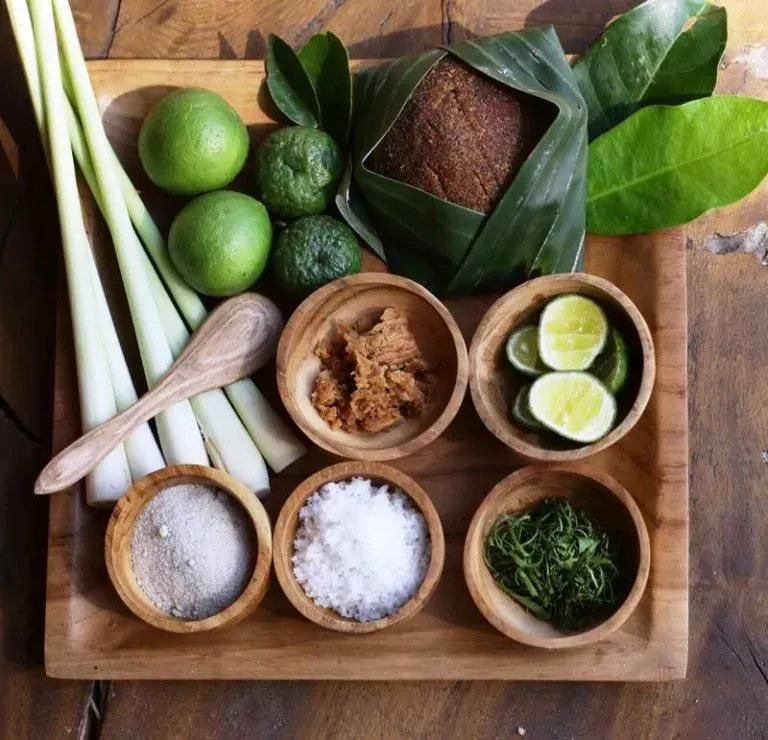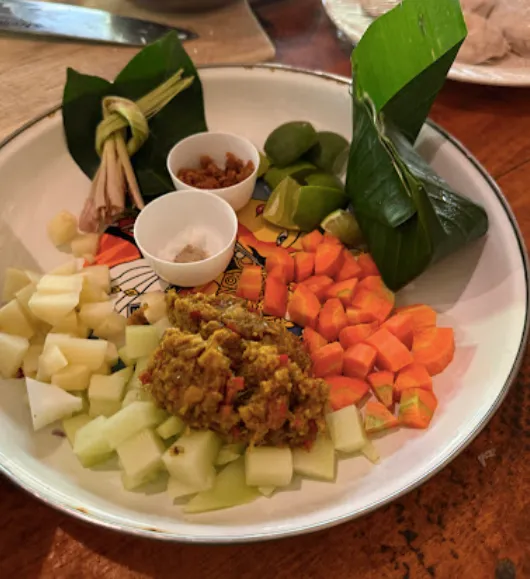If you’ve ever wandered through Bali’s lush rice fields or followed the scent of lemongrass drifting from a village kitchen, you know that food here isn’t just about eating. It’s storytelling. It’s history on a plate. Balinese cuisine is deeply rooted in ritual, community, and devotion—yet in recent years, it has also become a playground for creativity. Modern Balinese cuisine isn’t about leaving tradition behind. It’s about letting it evolve.
In this article, we’ll explore how today’s chefs are reimagining Balinese dishes for a global audience while staying true to the soul of the island. From smoke-filled warungs to fine dining restaurants like Locavore and Mozaic, this is the story of how Balinese food has stepped confidently into the modern culinary world.
A Taste of Tradition: The Soul of Balinese Cuisine
Before we talk about modern interpretations, it helps to understand what makes Balinese food so special. Traditional Balinese cuisine is built on the island’s abundant natural ingredients and its deep connection to ritual and religion. Meals are often prepared communally, especially during ceremonies and temple festivals. Food isn’t just nourishment—it’s an offering to both people and the gods.
At the heart of almost every dish lies base genep, the legendary spice paste that captures the island’s complex flavor profile. Made from shallots, garlic, turmeric, galangal, coriander, and chili, this paste is the foundation of countless recipes. When combined with coconut milk, lemongrass, and kaffir lime leaves, it gives Balinese food that unmistakable fragrance travelers never forget.
Staple dishes like babi guling (spit-roasted suckling pig), ayam betutu (slow-cooked spiced chicken), and lawar (a seasoned mix of vegetables, coconut, and minced meat) showcase the balance of spice, texture, and ceremony that define Balinese cooking. But now, a new generation of chefs is asking: how do we keep this heritage alive in a changing world?
The Rise of Modern Balinese Cuisine
Modern Balinese cuisine began not as a trend, but as a conversation. When international visitors started arriving in the 1990s and early 2000s, Bali’s dining scene expanded dramatically. Global cuisines flooded the island—Italian, Japanese, Mediterranean—and local chefs began to wonder how Balinese food could hold its own while appealing to a more diverse audience.
Enter a wave of passionate culinary innovators who didn’t want to westernize Balinese food, but rather reinterpret it. They started experimenting with techniques, presentation, and ingredient sourcing, while keeping the essence of the island intact.
This movement wasn’t just about flavor. It was about identity. It was about showing that Balinese cuisine could be both ancient and avant-garde.
Locavore: Leading the Culinary Revolution
If you talk about modern Balinese cuisine, you can’t skip Locavore, the Ubud-based restaurant that has become synonymous with the island’s culinary evolution. Founded by chefs Eelke Plasmeijer (Netherlands) and Ray Adriansyah (Indonesia), Locavore champions local ingredients with global techniques. Every dish on their menu is a story about Bali—its farmers, its foragers, and its traditions.
Imagine smoked duck paired with pickled vegetables grown just a few kilometers away, or seaweed transformed into a delicate crisp served with fermented sambal. The creativity lies not in abandoning tradition, but in amplifying it.
Locavore’s success has inspired countless young chefs to dig deeper into local ingredients and to see Balinese food not as rustic fare, but as art. The restaurant’s commitment to sustainability and seasonality also reflects a broader global shift toward conscious dining—and Bali, with its fertile soil and vibrant markets, is the perfect stage for it.
Mozaic: Fine Dining with a Local Heart
Another pioneer in Bali’s modern food scene is Mozaic, founded by chef Chris Salans in Ubud. Mozaic is known for blending French cooking techniques with Indonesian flavors. Think foie gras served with tamarillo sambal, or scallops paired with Balinese base genep. The result? A menu that feels familiar yet utterly new.
What sets Mozaic apart is its respect for Indonesian terroir. Salans doesn’t import luxury ingredients to impress—he elevates what’s already here. His tasting menus often feature spices, fruits, and herbs sourced from Bali’s highlands, giving diners a sense of place in every bite.
Mozaic paved the way for fine dining in Bali long before it became fashionable. Today, its influence can be seen across the island, from the kitchens of Seminyak to the beachside resorts of Canggu.
Nusantara: Going Back to the Roots
While some chefs explore fusion, others are focused on authenticity. Nusantara by Locavore, a sister restaurant to Locavore, celebrates Indonesia’s regional dishes, including many from Bali. The approach here is more grounded—less about reinvention, more about preservation.
In Nusantara’s kitchen, you’ll find cooks grinding spices by hand and recreating recipes passed down through generations. Yet, the presentation and dining experience still feel modern. This balance of authenticity and refinement is what makes the restaurant so beloved among food enthusiasts.
For visitors, Nusantara offers something deeper than a meal: a chance to experience Indonesia’s culinary diversity while understanding the roots that bind them—from the fiery sambals of Sumatra to the aromatic soups of Bali.
Cuca: Playful and Unexpected
In Jimbaran, Cuca offers a completely different take on Balinese-inspired dining. Helmed by chef Kevin Cherkas, who previously worked in Michelin-starred restaurants in Spain and Singapore, Cuca takes familiar Indonesian flavors and turns them into something entirely new. Think crispy chicken with sweet soy glaze, Bali-style ceviche with kaffir lime, or their famous “bali breakfast” dessert made with coconut ice cream and seasonal fruits.
Cuca’s philosophy is simple: local produce, global creativity. The restaurant’s playful approach has made it a favorite among those looking for something unexpected—proof that Balinese cuisine can evolve without losing its heart.
Tradition as the Foundation for Innovation
What unites all these chefs and restaurants is respect. Respect for the land, for the farmers, and for the generations that built the flavors we know today. Modern Balinese cuisine isn’t a rebellion against tradition—it’s an evolution built upon it.
Chefs are learning from village cooks, sourcing ingredients directly from local markets, and applying modern techniques to age-old recipes. The results are dishes that not only taste extraordinary but also tell stories of sustainability, community, and cultural pride.
Take, for example, a reinterpretation of lawar. Traditionally, it’s made from minced meat, grated coconut, and rich spices. In a modern restaurant, you might find a vegetarian version featuring jackfruit, cashew nuts, and a light coconut foam—the same flavor spirit, but in a new, refreshing form.
A Culinary Bridge Between Past and Present
Modern Balinese cuisine does more than just please the palate. It builds bridges—between old and new, between locals and travelers, between Bali’s humble roots and its cosmopolitan future.
In this balance lies its beauty. You can sit in a fine dining restaurant in Ubud, eating a delicate reinterpretation of betutu, and still feel the warmth of the island’s traditional hearth. You can wander into a warung and taste a dish so profound in its simplicity that no amount of Michelin stars could improve it.
Food in Bali reminds us that evolution and authenticity aren’t enemies—they’re partners.
Why Modern Balinese Cuisine Matters
To the casual traveler, modern Balinese cuisine might seem like another culinary trend. But to the people who live and cook here, it’s something more profound. It’s a way of preserving culture in motion. It’s proof that tradition doesn’t have to be static to be respected.
Every innovative plate that leaves a chef’s kitchen is a love letter to the island. It speaks of history, geography, and human creativity all at once. And for Bali—a place where art and spirituality intertwine so effortlessly—that’s only fitting.
The Future of Balinese Cuisine
As Bali continues to attract global attention, its food scene is evolving faster than ever. New chefs are experimenting with plant-based interpretations of classic dishes. Local producers are collaborating with restaurants to promote organic farming. Culinary schools on the island are teaching young cooks to see Balinese cuisine not as something to imitate, but as something to innovate from.
The next decade may see even more creative partnerships between tradition and technology—like digital storytelling for recipes, or immersive culinary tours that connect visitors directly with local farmers and cooks.
But at its heart, the essence will remain the same: fresh ingredients, deep respect for culture, and the joy of sharing food with others.
Experiencing Modern Balinese Cuisine for Yourself
If you’re planning a trip to Bali, the best way to understand modern Balinese cuisine is to taste it from multiple perspectives:
- For innovation: Dine at Locavore or Mozaic in Ubud.
- For authenticity: Visit Nusantara or a local warung serving traditional dishes.
- For playfulness: Head to Cuca in Jimbaran.
- For discovery: Take a Balinese cooking class and learn the foundations of base genep firsthand.
Each experience reveals a different layer of the same story—one that begins in ancient village kitchens and continues in today’s bustling dining rooms.
Conclusion: A Living Tradition
Modern Balinese cuisine is more than a culinary style. It’s a living conversation between the past and the present. It honors the island’s traditions while embracing creativity and global perspectives. It invites travelers not only to taste Bali but to understand it.
So, when you next sit down to a plate of betutu or savor a modern reinterpretation of lawar, remember—you’re tasting more than a recipe. You’re tasting centuries of culture, blended with the imagination of today’s best chefs. You’re tasting Bali itself.
And that, perhaps, is the true flavor of modern Balinese cuisine.






